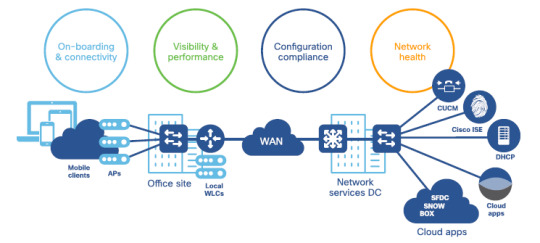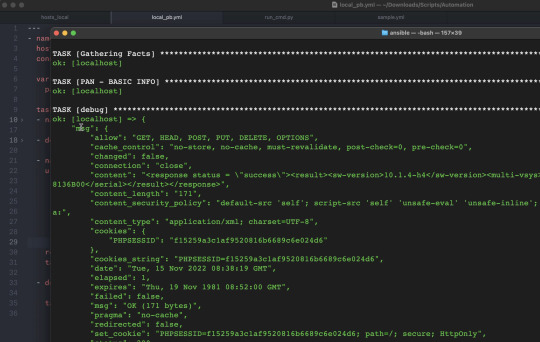#NetworkAutomation
Explore tagged Tumblr posts
Text


Explore Cisco SD-Access concepts and enhance network security and automation. Master software-defined networking with our in-depth course. https://www.dclessons.com/category/courses/SD-Access
0 notes
Text
#BroadbandGateway#BNGMarket#NetworkSolutions#BroadbandServices#TelecomInfrastructure#NextGenNetworking#DigitalInfrastructure#VirtualBNG#5GNetworks#SDNandNFV#NetworkAutomation#USBroadband#NorthAmericaBNG#BroadbandEurope#DigitalEurope#APACConnectivity#AsiaBroadband#MEAConnectivity#BroadbandMEA#BroadbandLATAM#ConnectivityLATAM
0 notes
Text
A Step-by-Step Approach to Mastering CCIE Service Provider Certification
Accomplishing the CCIE Service Provider certification requires a systematic and strategic approach. This comprehensive direct gives a step-by-step roadmap to acing the ccie service provider training programe certification. From foundational knowledge to progressed topics, you'll pick up the expertise needed to exceed expectations in service supplier networks. Take after our organized path, use practice exams, and sharpen your aptitudes to become a certified master in benefit supplier advances. Take the primary step toward your CCIE SP certification journey today!

0 notes
Text

Network Automation . . . . for more information https://bit.ly/3WW72YP check the above link
#wirelesssecurity#wireless#quantumnetworking#networkautomation#topologies#router#switch#internet#intranet#javatpoint
0 notes
Text
DDI Market on Track to Reach $5.8 Billion by 2034 – 8.8% CAGR
DDI (DNS, DHCP, and IP Address Management) market encompasses solutions that streamline the management of network services essential for modern IT infrastructures. It includes software and hardware tools that automate and integrate DNS and DHCP services with IP address management, enhancing network efficiency, security, and compliance. This market is driven by the increasing complexity of network environments, the proliferation of connected devices, and the need for robust, scalable solutions to support digital transformation initiatives across industries.
To Request Sample Report : https://www.globalinsightservices.com/request-sample/?id=GIS20287 &utm_source=SnehaPatil&utm_medium=Article
The DDI (DNS, DHCP, and IP Address Management) market is witnessing robust growth, propelled by the increasing complexity of network infrastructures and the proliferation of connected devices. DNS services lead the market, driven by the critical need for efficient domain name resolution in expanding digital ecosystems. DHCP services follow closely, supported by the demand for automated IP address allocation in dynamic network environments. IP Address Management solutions are gaining momentum, reflecting the necessity for centralized control and visibility in IP address distribution.
Geographically, North America stands at the forefront, benefiting from advanced technological adoption and a strong emphasis on cybersecurity. Europe ranks as the second-highest performing region, with regulatory compliance and data protection initiatives fueling market expansion. Within these regions, the United States and Germany emerge as key contributors, owing to their robust IT infrastructure and innovation-driven economies. The Asia-Pacific region is poised for rapid growth, driven by digital transformation initiatives and burgeoning telecom sectors.
Market Segmentation
Type: Software, Hardware, Services
Product: Integrated Platforms, Standalone Solutions, Cloud-based Systems, On-premise Systems
Services: Consulting, Implementation, Support and Maintenance, Managed Services
Technology: AI and Machine Learning, Blockchain, IoT Integration, Big Data Analytics, Automation, Cloud Computing
Component: Network Components, Security Components, Database Components, Interface Components
Application: Network Management, Data Management, Security Management, Compliance Management
Deployment: Cloud, On-premises, Hybrid
End User: Telecommunications, IT and ITeS, Banking, Financial Services, and Insurance, Healthcare, Retail, Manufacturing, Government, Education
In 2024, the DDI (DNS, DHCP, and IPAM) Market was characterized by a total volume of approximately 150 million units, projected to grow to 250 million units till 2028. The DNS segment commands the largest market share at 45%, followed by DHCP at 30%, and IPAM at 25%. The DNS segment’s dominance is driven by the increasing demand for scalable network solutions and enhanced security features. Prominent players in the market include Infoblox, BlueCat Networks, and EfficientIP, each holding substantial market positions. Infoblox leads with a focus on automation and security enhancements, while BlueCat Networks emphasizes cloud integration.
#ddi #dns #dhcp #ipmanagement #networksecurity #cybersecurity #cloudcomputing #iot #bigdata #automation #machinelearning #blockchain #networkinfrastructure #telecommunications #digitaltransformation #dataprotection #networkefficiency #aiintegration #networksolutions #hybridcloud #datamanagement #managedservices #networkautomation #cloudsecurity #networkmonitoring #datacenter #5gtechnology #networking #ipaddressmanagement #cyberthreats #smartnetworks #digitalinnovation #regulatorycompliance #networkvisibility #cloudintegration #networkperformance #scalablenetworks #enterpriseit #ddiservices #infosec #softwaredefinednetworking
0 notes
Text
NetBox Docker Compose Install Example
NetBox Docker Compose Install Example @vexpert #vmwarecommunities #netbox #networkautomation #networksolesourceoftruth #homelab #homeserver #cooldockercontainers #bestdockercontainers #virtualization #selfhosting
The NetBox solution is a great tool that can allow you to document and have a single source of truth for your network and infrastructure. Network and infrastructure engineers can use it as the starting point for driving automation and data center infrastructure management, as well as things like IP address management. Table of contentsQuick overview of NetBoxNetBox Prerequisites and…
0 notes
Text
Sending REST APIs in Playbooks

Hello Networkers,
We have released a new update to our existing ‘Network Automation using Ansible’ course we will show you how you can run python scripts inside of an Ansible playbook utilizing the shell module. Another type of task we can run is sending REST API requests inside of a playbook. For this example we will send a request to one of my Palo Alto Network firewalls to get some basic system information..
You can get more details here:
https://www.routehub.net/course/ansible/
8 notes
·
View notes
Text
Network Automation Market - Global Opportunity Analysis and Industry Forecast (2021-2028)
Meticulous Research® – a leading global market research company published a research report titled “Network Automation Market by Component, Deployment Mode, Industry Size, Networking Type (Physical Networking, Virtual Networking, Hybrid Networking), Industry Vertical (CSPs, Data Centers, and Enterprises)– Global Forecast to 2028.”
According to this latest publication from Meticulous Research®, the global network automation market is expected to grow at a CAGR of 22.8% from 2021 to 2028 to reach $32.4 billion by 2028. This market is majorly driven by the factors such as the increasing demand for smart healthcare systems with intent-based networking technology, the growing need to detect and identify old hardware, compliance and storage issues, and the increasing need for zero-touch provisioning and unified network visibility.
Furthermore, rising demand for connecting data centers, increasing demand to secure and meet compliance standards, and rising need for cloud-based network function virtualization (NFV) platforms by the telecommunication industry are expected to offer significant growth opportunities for players operating in the network automation market. However, the increasing availability of open-source automation tools and the negative impact of COVID-19 on the global economy have impacted the market growth considerably.
Download Free Sample Report Copy Here:https://www.meticulousresearch.com/download-sample-report/cp_id=5202

Scope of the Report
Network Automation Market, by Component
Solutions / Software
Configuration Management Tools
SD-WAN and Network Virtualization Tools
Intent-based Networking Solutions/Platforms
Other Network Automation Tools
Professional Services
Advisory, Analytics & Automation
Deployment & Integration
Training & Supporting
Network Automation Market, by Deployment Mode
On-premise
Cloud-based
Network Automation Market, by Industry Size
Large Enterprises
Small and Mid-Sized Enterprises
Network Automation Market, by Networking Type
Physical Networking
Virtual Networking
Hybrid Networking
Network Automation Market, by Industry Vertical
CSPs
Data Centers
Enterprises
IT & Telecommunication
Manufacturing
Government & Public Sector
Retail
BFSI
Healthcare and Life Science
Education
Energy and Utilities
Media & Entertainment
Other Industry
Network Automation Market, by region
North America
U.S.
Canada
Europe
Germany
U.K.
France
Italy
Spain
Netherlands
Rest of Europe
Asia-Pacific
Japan
China
India
South Korea
Thailand
Indonesia
Australia & New Zealand
Rest of Asia-Pacific
Latin America
Brazil
Mexico
Rest of Latin America
Middle East & Africa
Saudi Arabia
UAE
Israel
Rest of MEA
Speak to our Analysts to Understand the Impact of COVID-19 on Your Business: https://www.meticulousresearch.com/speak-to-analyst/cp_id=5202
The global network automation market study presents historical market data in terms of value and volume (2019 and 2020), estimated current data (2021), and forecasts for 2028. The market is segmented based on component (solutions/software, professional services), deployment mode (on-premise and cloud-based), industry size (large enterprises, small and mid-sized enterprises), networking type (physical networking, virtual networking, hybrid networking), industry vertical (CSPS, data centers, and enterprises). The study also evaluates industry competitors and analyses the market at a country level.
Based on component, the network automation market is segmented into software/solutions and professional services. In 2021, the solutions segment is expected to account for the largest share of the network automation market. The large share of this segment is mainly attributed to the rising investment in R&D activities, increasing and varying connectivity demands by communication service providers, and the presence of well-established network automation solution providers.
Based on deployment mode, the network automation market is segmented into on-premise and cloud-based. In 2021, the on-premise segment is expected to command the largest share of the network automation market due to the acceptance of network automation solutions among large enterprises, rising demand for advanced security and control, and increasing deployment of network automation solutions across on-premise data centers. However, the cloud-based segment is expected to grow at the highest CAGR during the forecast period. The growing sophistication in cloud deployments, increasing use of cloud networks, and superior flexibility offered by cloud deployments are the factors driving the growth of this segment.
Based on industry size, the network automation market is segmented into large-size enterprises and small & mid-sized enterprises. In 2021, the large enterprises segment is expected to command the largest share of the network automation market. The large share is majorly attributed to the rising demand by the largest telecommunication service providers and increasing demand for network automation solutions by large data centers and campus environments. Moreover, the small and mid-sized enterprises segment is expected to grow at the highest CAGR during the forecast period. The need to create an agile, secure, and efficient work environment and growing demand by SMEs such as education, retail, healthcare, manufacturing, government, and manufacturing industries are the factors driving the growth of this segment.
Based on networking type, the network automation market is segmented into physical networking, virtual networking, and hybrid networking. In 2021, the physical networking segment is expected to command the largest share of the network automation market. The large share of this segment is mainly attributed to the rising demand to manage the complexities of modern and dynamic networks and orchestrate services in a physical network and rising demand to monitor networks infrastructure for solving issues across the physical network.
However, the virtual networking segment is expected to record the highest growth over the forecast period. Rising need to reduce manual work of network configuration, growing demand to reduce costs and speed up the delivery of network-based services, increasing emphasis of leading players to deploy virtualized applications and rising demand for faster troubleshooting from fault detection to fault isolation is expected to support the segment’s high growth rate.
Based on industry vertical, the network automation market is segmented into CSPs, data centers, and enterprises. In 2021, the data centers segment is expected to command the largest share of the network automation market. The large share of this segment is mainly attributed to the growing demand to automate routine workflows and processes of data centers, increasing deployments of network automation solutions for data centers, and the growing need to reduce repetitive or mundane tasks, speed up processes, and drive down overhead in data centers.
To gain more insights into the market with a detailed table of content and figures, click here: https://www.meticulousresearch.com/product/network-automation-market-5202
However, the enterprises segment is expected to record the fastest growth over the forecast period. The rising demand for network automation solutions that integrates with multiple vendors and environments, rising demand for network automation solutions from enterprises, and increasing deployments of network automation solutions across several enterprises are expected to support the segment’s high growth rate.
Geographically, the North American region is expected to command the largest share of the network automation market in 2021. North America keenly focuses on adopting network automation solutions to enhance its network infrastructure and leverage the benefits of new technologies, such as virtual networking and software-defined networking. Furthermore, several enterprises in the region are adopting network automation solutions to enhance their IT infrastructure and leverage the benefits of automated networking solutions such as enhanced security, reduction in manual working, and increased productivity.
However, Asia-Pacific is expected to grow with the highest growth rate over the forecast period. The region's high growth rate is attributed to growing telecommunication sectors across several developing countries and several smart cities projects undertaken. The introduction of 5G in the region is also expected to help the region to grow significantly.
Check Discount Here: https://www.meticulousresearch.com/request-discount/cp_id=5202
Key Players:
The key players operating in the global network automation market are Cisco Systems, Inc. (U.S.), VMware, Inc. (U.S.), Red Hat, Inc. (U.S.), IBM Corporation (U.S.), Juniper Networks, Inc. (U.S.), Micro Focus International plc (U.K.), BMC Software, Inc. (U.S.), Fujitsu Group (Japan), AppViewX (U.S.), Telefonaktiebolaget LM Ericsson (Sweden), Forward Networks, Inc. (U.S.), SolarWinds Corporation (U.S.), Apstra (U.S.), NetBrain (U.S.), BlueCat Networks (Canada), Itential (U.S.), NetYCE (Netherlands) Microsoft Corporation (U.S.), Hewlett Packard Enterprise Development LP (U.S.), Dell Technologies, Inc. (U.S.), NVIDIA Corporation (U.S.), Huawei Technologies Co., Ltd. (China), Arista Networks, Inc. (U.S.), Anuta Networks International LLC (U.S.), Nokia Corporation (Finland), Palo Alto Networks, Inc. (U.S.), and Fortinet, Inc. (U.S.).
Key questions answered in the report-
Which are the high-growth market segments in terms of the component, networking type, industry size, deployment mode, industry vertical, and countries?
What is the historical market for network automation across the globe?
What are the market forecasts and estimates from the period of 2021-2028?
What are the major drivers, restraints, and opportunities in the global network automation market?
Who are the major players in the global network automation market, and what market share do they hold?
How is the competitive landscape of the global network automation market?
What are the recent developments in the global network automation market?
What are the different strategies adopted by the major players in the market?
What are the geographic trends and high growth countries?
Who are the local emerging players in the global network automation market, and how do they compete with the other players?
Contact Us:
Meticulous Research®
Email- [email protected]
Contact Sales- +1-646-781-8004
Connect with us on LinkedIn- https://www.linkedin.com/company/meticulous-research
1 note
·
View note
Text
Should you build or buy a network automation solution?
As networks grow in complexity, the demand for automation is ever increasing. Every network architect is looking for ways to eliminate tedious, error-prone manual operations and embrace automation to free time for more value-added activity. From onboarding multi-vendor, multi-domain devices to monitoring, troubleshooting, and remediating network issues – automation has the capability to revolutionize networking.
When do you require network automation?
Are you excited about an entirely self-driven autonomous smart car? Probably not. However, you probably appreciate automatic transmission as well as cruise control and other features that facilitate easy driving. Much like smart cars, the journey towards network automation will be gradual. Are network architects and network administrators ready for a self-driving network? Possibly, but most architects want some level of control in steering network operations and are unwilling to take the back seat. However, solutions that can automate mundane tasks are overwhelmingly welcomed. In a network world of multi-vendor infrastructure and devices, on-boarding, maintaining configuration, and detecting and remediating compliance violations becomes a daunting task. It is nearly impossible to monitor and troubleshoot a vast network manually or draw any insights given the lack of scalability. Automation tools have been trying to solve this challenge and have been successful in providing some value to the administrators. Tools such as Ansible help you push configuration changes to devices automatically. Netbox, Github, and others help track configuration drifts, and Python is used to add intelligence into the automation framework. Collected network data can also be stored in open source time-series databases like Prometheus and Influx, which when integrated with Grafana help provide visibility and insights into the network. While you can get started quickly with these tools and achieve some level of automation, what is required in the long run is a more robust and comprehensive automation solution.
What constitutes a comprehensive network automation solution?
Network administrators and architects have been test-driving various in-house, open-sourced and commercial automation solutions for quite some time. While some solutions are low code and easy to deploy, many lack the capacity and scalability for long term needs. On the other end of the spectrum, there are robust offerings equipped with shock absorbing and disaster recovery features, but they require a large footprint and have limited compatibility with only a small subset of vendors. A comprehensive network automation solution automates the complete end-to-end device and service lifecycle. Moreover, it can scale to support a large number of vendors as well as provision devices, collect specific network information, and provide analytics distinct to particular use cases. An easily scalable solution with a small footprint, allows network operators to start small and grow with automation confidence. Constant monitoring of all devices anticipates possible configuration, compliance or other network issues and automatically remediates issues with known solutions. The solution also integrates with ServiceNow, Jira, and other ticketing and billing systems to provide you a complete end to end closed-loop automation platform.
Look before you leap
The first instinct towards automating your network is the confidence that it can be done in-house with standard tools or custom scripting. Some common pitfalls include: Let’s try it ourselves. There is a ton of free automation tools. Many companies have done it internally. We have already automated a part of our network so why should we waste money by buying a packaged solution? While a homegrown automation solution might appear plausible initially, it may be wiser to ask the following questions:
How many automation tools can we learn and handle? Each tool is specialized in its area – such as Ansible for configuration, Netbox for IPAM, Prometheus for database, and Python for intelligence. Comprehending and maintaining every tool can become cumbersome.
How much integration support do we get? For a complete closed loop automation integration with ticketing/billing/OSS/BSS are the fundamental underlying requirements. If the tools do not comprehend these capabilities, is the support readily available or will it have to be built?
How do I develop automation scripts? Developing an automation framework itself becomes a project on its own. Significant resources will have to be allocated in order to plan for software versioning, maintenance, and upgrades of automation scripts.
How do we handle scripting issues? You have to worry not only about your network but also your script bugs that can adversely impact your automation system. You will have to learn low-level OS integrations to optimally scale scripts.
How many resources can I dedicate towards automation? A project of significant size and scope requires dedicated resources to create and maintain various automation scripts.
How much risk am I willing to take? A project of this scale may take years to complete. Even then, it may not meet intent or expectations of the lines of businesses that are supported. Are you willing to risk failure?
Will my network get locked to a single vendor? It’s easy to automate when there is uniformity. If all scripts are tailored towards a particular single vendor, it could become exceedingly difficult to move to other vendors that might bring a best of breed approach for a particular workflow or set of applications.
What happens if key team members leave? This is perhaps one of the most challenging questions to answer. If your key team members that designed and developed the automation system leave the organization, how could it impact ongoing network operations?
When should you consider deploying a packaged automation solution?
Smaller networks might lend themselves to an internally developed automation solution, but maintenance and future scalability are still risk points. On the other hand, larger, more extensive multi-vendor and multi-domain networks will benefit greatly from a packaged, microservices based automation solution. The following checklist might provide insight into determining the fit of a packaged solution:
Is there a need to automate more than 500 devices on a given network?
Are there more than 2 vendors in a given network?
Do network operations need to be tied to business operations? I.e. integration of network workflows with ServiceNow/Jira, etc.
Is a single pane of glass desired to manage a given network, or can it be managed with multiple, distributed interfaces?
Is efficient provisioning required to effectively scale an automation framework as a network grows?
Is network enhancement and future proofing a long term objective?
If the answer is yes to any of these questions, consider Anuta Networks ATOM for your network automation needs. Wantto learn more? Visit
www.anutanetworks.com
.
10 notes
·
View notes
Text
Revolutionize Your Network Management
Auvik is a comprehensive network management software that offers a wide range of features designed to help managed service providers (MSPs) and IT professionals manage and monitor their clients' network infrastructure. Here are some of Auvik's key features:
Network discovery and mapping: Auvik can automatically discover and map all devices on a network, including routers, switches, firewalls, and servers, providing MSPs and IT professionals with a complete picture of their clients' network infrastructure.
Real-time network monitoring: Auvik provides real-time monitoring of network devices and services, including bandwidth usage, CPU and memory utilization, and error rates, allowing MSPs and IT professionals to quickly identify and troubleshoot network issues.
Network automation: Auvik offers powerful automation capabilities that can streamline routine tasks, such as device configuration, firmware updates, and backups. This can save MSPs and IT professionals time and reduce the risk of errors.
Alerting and reporting: Auvik can generate alerts for network issues, including device failures, configuration changes, and security threats. It also provides customizable reports that can help MSPs and IT professionals track network performance and identify trends over time.
Security and compliance: Auvik offers built-in security features, such as multi-factor authentication and data encryption, to help protect sensitive network data. It also supports compliance with regulations such as HIPAA and PCI DSS.
Integration with other tools: Auvik can integrate with other popular network management and automation tools, such as ConnectWise and Autotask, allowing MSPs and IT professionals to easily incorporate it into their existing workflows.
Overall, Auvik is a powerful network management solution that offers a wide range of features designed to help MSPs and IT professionals manage and monitor complex network infrastructure with ease.
#Auvik#networkmanagement#MSPs#ITprofessionals#networkdiscovery#networkmapping#networkmonitoring#networkautomation#alerting#reporting#security#compliance#networksecurity#datasecurity#HIPAA#PCIDSS#ConnectWise#Autotask#networkperformance#networkinfrastructure#managedservices#cloudmanagement#networkadmin#ITmanagement#techsolutions#networktech#ITsupport#networksupport#businesssolutions#productivity
0 notes
Text


Master Cisco DNA Center’s automation and management capabilities. DCLessons offers comprehensive guides for efficient network management. https://www.dclessons.com/category/courses/cisco-dna-dna-c
0 notes
Text
0 notes
Link
NetBox is an infrastructure resource modeling (IRM) application designed to empower network automation. NetBox was developed specifically to address the needs of network and infrastructure engineers. It is intended to function as a domain-specific source of truth for network operations.
#netbox#ubuntu#hostnextra#networkautomation#automation#linux#linuxtutorials#linuxserver#ubuntuserver#networkengineer#python#django#postgresql#database#tech#techworld#technology#howto#knowledgebase
0 notes
Text

Quantum Networking . . . . for more information https://bit.ly/45PMd5r check the above link
#wirelesssecurity#wireless#quantumnetworking#networkautomation#topologies#router#switch#internet#intranet#javatpoint
0 notes
Text
How Much Do You Know About Network Management?

How Much Do You Know About Network Management? Automate Your Network in a Few Easy Steps
Are your business operations running at peak performance? Is your business network always available and accessible? If you’re running a business online, you know how important it is to keep your business network fully optimized, manageable, and effective. A business network management system is a critical part of any corporate IT infrastructure. Hence, network automation's main goal is to help companies minimize disruptions to their operations, enhance performance, and mitigate any security vulnerabilities on the go. The scalability, flexibility, reliability, and security of your network architecture depend on the selection of networking tools you opt for. However, the flexibility of your entire business depends on the network management practices and technologies that help tackle all the challenges of running a business in a digital environment. That’s why network automation makes all the difference when securing your data, preventing cyber threats, and ensuring maximum uptime. Read on to find out more about how to automate your network management and simplify your processes. Automate your business processes The first step should be automating your operation processes to improve your efficiencies and minimize human error, leading to higher costs and dangerous security risks. Automation is key to saving time, effort, and resources while developing and managing an effective, centralized, and agile business network. It also ensures better consistency across your operations by eliminating repetition and delivering process automation to your core IT operations. So, automating your operations allows you to interconnect your existing digital systems and improve communication regarding handling any network issues. More importantly, an agile and fully efficient business network allows you to make better use of your network data. It makes network infrastructure maintenance more straightforward, saving costs in the process. Automate firmware configuration and updates The main goal of automating your processes is to remove as many repetitive and manual tasks as possible. Since scaling is one of the crucial determining factors of your competitiveness, you can save a lot of time and resources by automating firmware configuration and ensuring your business network keeps receiving updates on time. You can free your IT department and allow it to focus on the core mission while your automated network management takes care of all the network-wide configuration changes that are necessary to scale your operations with success. Centralize support Most businesses use tools, technologies, and software components from multiple vendors to develop their enterprise networks to save resources. While this can be a more cost-effective solution, it can also expose your entire network system to a whole new range of risks and challenges, especially when it comes to network management. Because of that, it’s recommended that you centralize your network support by establishing one unified or centralized multi-vendor support to improve operational responsiveness and efficacy. Implement SD-WAN Implementing SD-WAN network architecture is perhaps the most vital aspect of automating your network management. Firstly, it refers to a virtual approach to connecting your business applications to matching end-users to define a software-based, wide-area, interconnected network that comprises a range of network-specific efficiencies. Such a network architecture can help simplify the complex process of maintaining and managing all processes regarding your corporate infrastructure. SD-WAN architecture offers a range of advantages for modern-day businesses, such as: - Increasing business agility, flexibility, and scalability; - Improving productivity; - Reducing operational costs; - Improving network security; - Enhanced application performance; - Data-driven and advanced traffic management; - Process simplification; - Mitigating security risks. A policy-driven, virtual business network infrastructure relies on the power of automation to configure and manage your entire network and allow you to increase control over your processes. Develop a policy-based network system Effective network management aims to automate as many network administration processes, tasks, and workloads as possible to save time, manpower, and resources. Tere’s a range of processes that you can automate. All you need is an effective system for configuring an effective solution for all your management systems. You do this by purchasing one unified, policy-based solution. It gives you the power of automation when dealing with the latest business standards, rules, and regulations. And then it ensures maximum compliance.
What is Network Management System?
A network management system (NMS) is an application or set of applications that allows network engineers to manage a network's independent components within a larger network management framework and performs a number of important functions. NMSs can be single applications or collections of applications. Over the course of the past decade, advancements in network management systems have made it possible for IT departments to function in a more agile manner. These systems now integrate sophisticated analytics, machine learning, and intelligent automation in order to continually improve network performance. These network management solutions are rapidly being used in cloud and hosted settings as businesses adjust to the more scattered workforces that are becoming the norm. How does a network management system accomplish its job? Data from linked network devices including switches, routers, access points, and client devices is gathered by network management systems. In addition to this, they provide network managers with granular control. So the data that is collected from these devices is utilized to expedite the troubleshooting process, as well as proactively detect performance problems, monitor security and segmentation, and so on. Conclusion Automation is the key to staying relevant, authoritative, and competitive in the digital business environment. Thus, automation solutions are on the rise among digital businesses. The more you automate, the more control you have over your essential business processes and data management. Hence, most businesses struggle with scaling their operations as their organizations grow. But you won’t have to think about such nuisances with effective and automated network management. Read the full article
0 notes
Text
Need for Network Automation & the skills needed for it.
A primary objective of modern IT professionals is to automate and secure your network while continuously maximizing its efficiency and functionality. Current businesses strive to attain faster, more agile infrastructure to manage their applications, conventional or cloud-based.
Network Automation can help by automating networking operations like resource provisioning, network mapping, and network testing. Moreover, it will comprehend network behaviours, provide predictive analysis, and provide insights to the network operations teams. Although, its primary goal is to handle manual tasks and processes that make the overall process quicker and more efficient.
Network automation software will discover the most efficient way to map, configure, and manage a network. The API-based Network Automation Software substitutes manual command-line instructions for configuring networks. These APIs can be built directly or call commands via a programming language, like Python or Java. A modern automation platform monitors grid resources when provisioning and diagnoses the network and whether it will abide by the configuration request before implementing it.
As network automation is one of the critical procedures supporting the development of intent-based networking and network validation, these ideas use software to map how companies can harness their resources to meet the business demands their networks need to support. Such advanced automation solutions configure remedial action autonomously, delivering closed-loop remediation of network problems at their occurrence or even before they occur.
Why do we need Network Automation?
Creating a dynamic network
Simplifying network management
Reduce errors & workloads
Help professionals focus on more valuable tasks
Read the full article & know more about the skills required to build your career in Network Automation.
#networkautomation#robotic process automation#network automation#rpa services#emerging technology#hyperautomation#productivity
0 notes